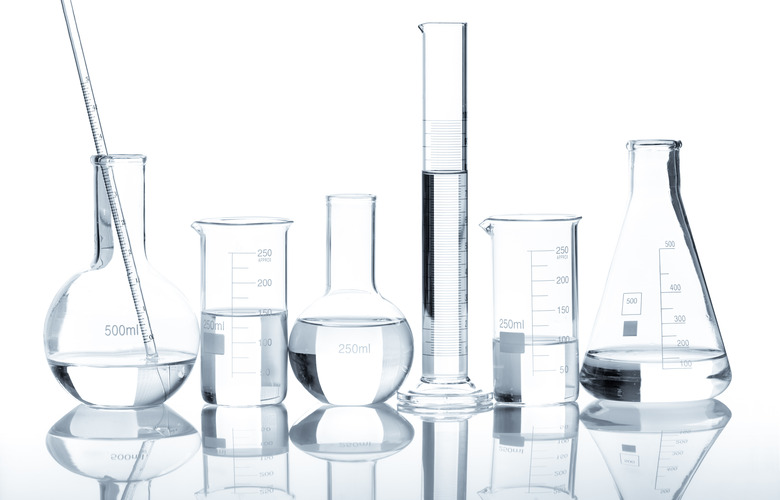How Do I Calculate The Amount Of Acid To Reduce Water pH?
The pH measures the amount of hydrogen ions in a solution. Basic solutions have low concentrations of hydrogen ions, while acidic solutions have high concentrations of hydrogen ions. The pH of solutions can be altered by adding acids and bases. Acids lower the pH while bases raise the pH. If you blindly mix an acid with water, you are unlikely to add the correct amount. If you put too much acid into a solution, you will have to use a base to raise the pH once again. To avoid wasting acids and bases, use a simple calculation to determine exactly how much acid you need.
1. Identify a Strong Acid
Obtain a strong acid, such as hydrochloric acid, hydrobromic acid and nitric acid, designated HCl, HBr and HNO_3, respectively. Strong acids have an extremely high concentration of hydrogen ions. Hydrogen ions make a solution acidic, while hydroxide ions make a solution basic.
2. Work out Molarity
Obtain the concentration of hydrogen ions, also known as molarity, in your strong acid. If you don't have the concentration, then you likely have the pH of the solution. If you have the pH, convert from pH to molarity by using the following equation:
Molarity = 10^-[pH]
If you have a number higher than 1, you likely made an error. However, if you have a very strong acid, its pH may be less than zero and yield a concentration more than 1. This resulting value is the molarity of the solution. Molarity is the amount of moles of acid per liter of solution. For example, if your solution has 0.5 molarity, then there is only 0.5 mol of acid per 1 L. Calculate molarity using this formula:
Molarity = moles of acid ÷ liters of solution
Find the molarity of your water sample using the same method.
3. Convert Target pH
Convert your target pH value into molarity using the equation in the previous step.
4. Calculate Acid Needed
Calculate how much acid you need to obtain the pH level of your target value. Work this out using the following formula:
M_1V_1 + M_2V_2 = M_3(V_1 + V_2)
In this equation, "M_1" is the molarity of the acid, "V_1" is the volume of the acidic solution, "M_2" is the molarity of the water and "V_2" is the volume of the water. Converting this equation to solve for "V_1" yields the following equation:
V_1 = (M_3V_2 – M_2V_2)/(M_1 – M_3).
References
Cite This Article
MLA
Miller, Charles Alex. "How Do I Calculate The Amount Of Acid To Reduce Water pH?" sciencing.com, https://www.sciencing.com/do-acid-reduce-water-ph-6890711/. 22 May 2018.
APA
Miller, Charles Alex. (2018, May 22). How Do I Calculate The Amount Of Acid To Reduce Water pH?. sciencing.com. Retrieved from https://www.sciencing.com/do-acid-reduce-water-ph-6890711/
Chicago
Miller, Charles Alex. How Do I Calculate The Amount Of Acid To Reduce Water pH? last modified March 24, 2022. https://www.sciencing.com/do-acid-reduce-water-ph-6890711/
